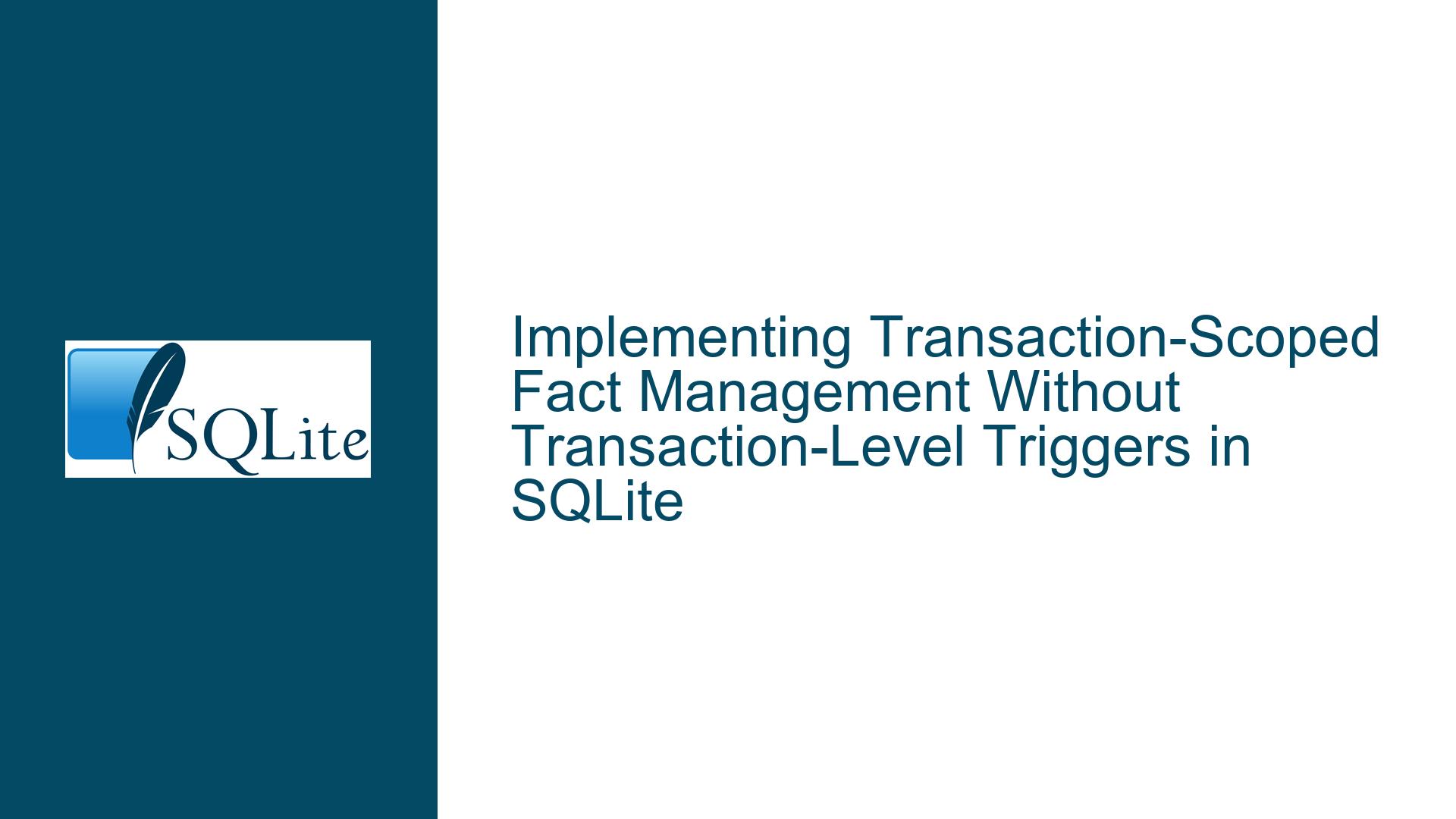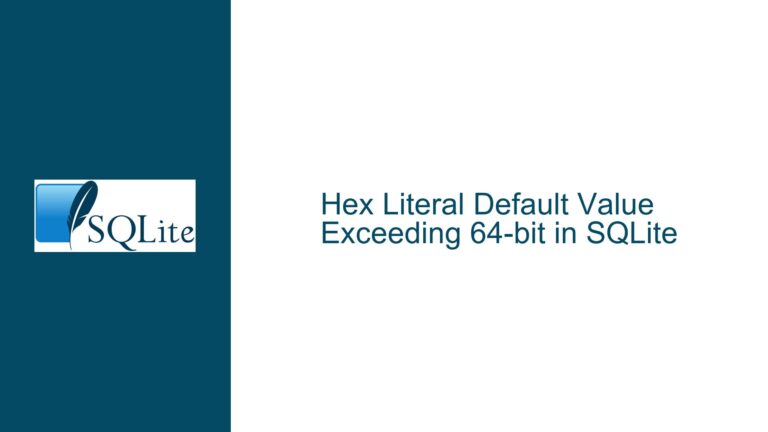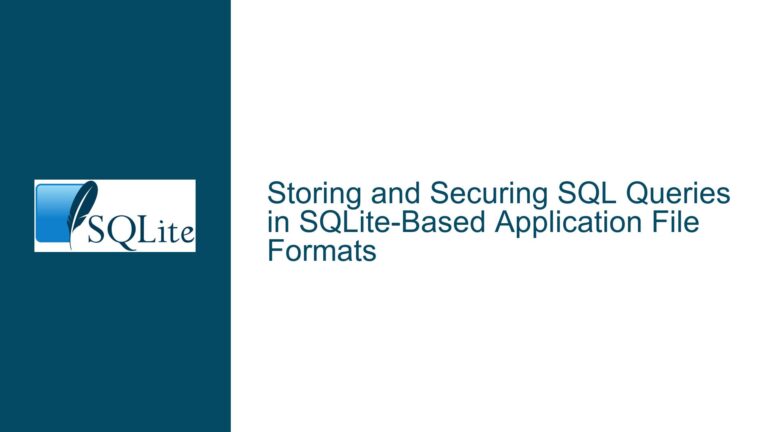Implementing Transaction-Scoped Fact Management Without Transaction-Level Triggers in SQLite
Issue Overview: Managing Fact Assertions/Retractions with Transaction-Scoped Identifiers
The core challenge involves designing a SQLite schema to manage temporal fact assertions and retractions using transaction-scoped identifiers while ensuring atomicity. The system requires all fact modifications (assertions via INSERTs and retractions via UPDATEs/DELETEs) within a transaction to reference a shared transaction identifier (tx_number). This identifier must be generated within the transaction to guarantee that rollbacks eliminate both fact modifications and their associated transaction record.
The schema uses two critical tables:
Transact: Stores transaction metadata with auto-incrementingtx_numberand timestamps.Fact_p: Stores facts with foreign keys (asserted,retracted) referencingTransact.tx_number.
A view (Fact) with INSTEAD OF triggers abstracts fact operations:
- INSERT into
Factsetsassertedto the current transaction’stx_number. - DELETE from
Factsetsretractedto the current transaction’stx_number(soft delete). - UPDATE is implemented as DELETE + INSERT to preserve history.
The critical limitation is SQLite’s lack of transaction-level triggers or statement-level triggers, which would allow automatic generation of a Transact record at transaction start. Without this, developers cannot guarantee that all fact operations in a transaction reference the same tx_number and that the Transact row is created atomically with fact modifications.
Possible Causes: Trigger Granularity and Transaction Metadata Isolation
Three architectural constraints create this problem:
1. Absence of Transaction-Bound Triggers
SQLite triggers are tied to table events (INSERT/UPDATE/DELETE), not transactional boundaries (BEGIN/COMMIT). A trigger cannot execute when a transaction starts, making it impossible to auto-generate a Transact row at BEGIN.
2. Row-Level Trigger Execution
SQLite supports only row-level triggers (FOR EACH ROW), which fire once per modified row. If a trigger on Fact_p attempted to create a Transact row, it would execute redundantly for each fact modification in the transaction, risking duplicate tx_number entries or requiring complex existence checks.
3. Transaction Metadata Isolation
The Transact table must be modified within the transaction to ensure rollback consistency. However, without a pre-existing tx_number, the first fact modification in a transaction cannot reference a Transact row that doesn’t yet exist. This creates a circular dependency: the Transact row must be created before fact modifications, but there’s no mechanism to enforce this order automatically.
Troubleshooting Steps, Solutions & Fixes: Schema Refinements and Pragma-Driven Workarounds
Solution 1: Pre-Insert Transact Rows with Application-Level Enforcement
Step 1: Explicit Transact Row Creation
Require applications to explicitly insert into Transact at the start of a transaction:
BEGIN;
INSERT INTO Transact (user) VALUES ('app_user');
-- Subsequent fact operations use last_insert_rowid() for tx_number
Step 2: Leverage last_insert_rowid()
In INSTEAD OF triggers on the Fact view, reference last_insert_rowid() to set asserted/retracted:
CREATE TRIGGER Fact_Insert INSTEAD OF INSERT ON Fact
BEGIN
INSERT INTO Fact_p (uuid, asserted, ...)
VALUES (NEW.uuid, last_insert_rowid(), ...);
END;
Drawbacks:
- Relies on application discipline to always insert into
Transactfirst. - Vulnerable to incorrect
tx_numberreferences if other INSERTs occur mid-transaction.
Solution 2: Singleton Transact Row with Transaction-Held Lock
Step 1: Use BEGIN EXCLUSIVE Transactions
Open transactions in EXCLUSIVE mode to lock the database, ensuring no concurrent writes:
BEGIN EXCLUSIVE;
INSERT INTO Transact (user) VALUES ('app_user');
-- Proceed with fact modifications
Step 2: Retrieve tx_number via MAX()
Modify INSTEAD OF triggers to reference the latest tx_number:
CREATE TRIGGER Fact_Insert INSTEAD OF INSERT ON Fact
BEGIN
INSERT INTO Fact_p (uuid, asserted, ...)
VALUES (NEW.uuid, (SELECT MAX(tx_number) FROM Transact), ...);
END;
Drawbacks:
EXCLUSIVElocks degrade concurrency.SELECT MAX()introduces overhead in largeTransacttables.
Solution 3: Temp Table for Transaction Context
Step 1: Create Transaction-Scoped Temp Table
At transaction start, create a temporary table to hold the tx_number:
BEGIN;
CREATE TEMP TABLE CurrentTx (tx_number INTEGER);
INSERT INTO Transact (user) VALUES ('app_user');
INSERT INTO CurrentTx VALUES (last_insert_rowid());
Step 2: Reference Temp Table in Triggers
Modify triggers to read tx_number from CurrentTx:
CREATE TRIGGER Fact_Insert INSTEAD OF INSERT ON Fact
BEGIN
INSERT INTO Fact_p (uuid, asserted, ...)
VALUES (NEW.uuid, (SELECT tx_number FROM CurrentTx), ...);
END;
Drawbacks:
- Requires modifying triggers to depend on temp tables.
- Temp tables are session-specific, complicating connection pooling.
Solution 4: Pragma-Controlled Transaction Hooks
Step 1: Use sqlite3_update_hook()
For applications with native code access, use the SQLite C API’s sqlite3_update_hook() to detect the first write operation in a transaction and inject a Transact INSERT:
void on_update(void *arg, int op, char const *db, char const *tbl, sqlite3_int64 rowid) {
if (!transaction_started) {
exec_sql("INSERT INTO Transact (user) VALUES ('app_user')");
transaction_started = 1;
}
}
sqlite3_update_hook(db, on_update, NULL);
Step 2: Map tx_number via last_insert_rowid()
As in Solution 1, triggers reference last_insert_rowid().
Drawbacks:
- Application code must manage hooks, conflicting with ORM layers.
- C API-centric, unusable from pure SQL or scripting languages.
Solution 5: Shadow Table with Delayed Trigger
Step 1: Buffer Fact Modifications in a Shadow Table
Create a shadow table to queue fact operations, then process them with a trigger on Transact:
CREATE TEMP TABLE FactBuffer (
operation TEXT, -- 'INSERT'/'DELETE'
uuid INTEGER,
...
);
CREATE TRIGGER Transact_AfterInsert AFTER INSERT ON Transact
BEGIN
-- Process buffered operations after Transact INSERT
DELETE FROM FactBuffer
RETURNING
CASE operation
WHEN 'INSERT' THEN
INSERT INTO Fact_p (uuid, asserted, ...)
VALUES (uuid, NEW.tx_number, ...)
WHEN 'DELETE' THEN
UPDATE Fact_p SET retracted = NEW.tx_number
WHERE uuid = uuid AND retracted IS NULL
END;
END;
Step 2: Route Fact Operations Through the Buffer
Modify the Fact view’s triggers to write to FactBuffer instead of Fact_p:
CREATE TRIGGER Fact_Insert INSTEAD OF INSERT ON Fact
BEGIN
INSERT INTO FactBuffer (operation, uuid, ...)
VALUES ('INSERT', NEW.uuid, ...);
END;
Drawbacks:
- Increases complexity with temporary tables and secondary triggers.
- Risk of unprocessed buffers if
TransactINSERT is omitted.
Final Recommendation: Hybrid Application-Database Approach
Combine Solution 1 (explicit Transact INSERTs) with Solution 3 (temp table context) for robustness:
- Applications begin transactions and explicitly create a
Transactrow. - Triggers reference
last_insert_rowid()or a temp table fortx_number. - Use
PRAGMA foreign_keys = ONto enforce referential integrity.
This balances explicitness with trigger automation, minimizing reliance on SQLite’s trigger granularity limitations.





